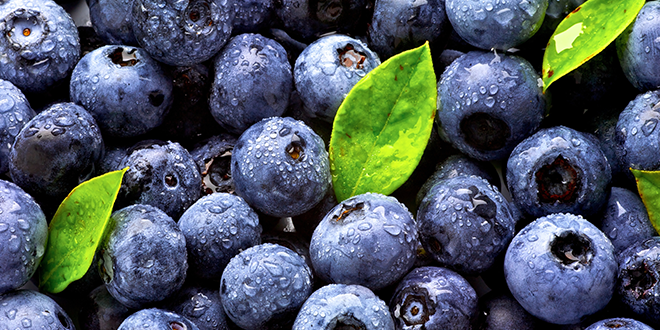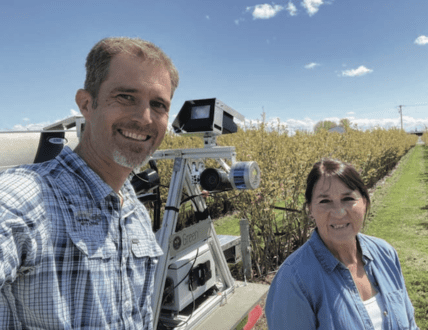

Aug 5, 2022Tech helps growers produce better blueberries
A marriage of technology and agronomics is helping growers harvest blueberries more efficiently.
In two Washington blueberry fields, the BerrySmart project is improving production quality through existing and future technologies that could benefit the industry.
At Applegate Orchards in Burbank, Washington, and Sakuma Bros. in Burlington, Washington, ag-tech startup innov8.ag, Walla Walla, Washington, is using sensors to more efficiently grow and harvest blueberries.
The farms, in southeast and northwest Washington, offer unique climates and environmental and agronomic challenges, said Kasey Cronquist, president of the U.S. Highbush Blueberry Council (USHBC) and the North American Blueberry Council (NABC), which, along with the Washington Blueberry Commission and innov8.ag, are sponsoring the research project.
“With costs going up, the way inputs are increasing, farm operation optimization is critical,” Cronquist said. “For us to remain profitable, technology will be an extremely important role going forward.”
Agronomic focus
BerrySmart gives growers a clearer picture of what’s happening with their crops during a season and from year to year. To better predict fruit volume sent to the market, accurate crop load management information is critical
“There is plenty of innovation in processing and distribution, but, surprisingly, there’s not a lot of quantifiability in being able to predict what’s in the field,” said Steve Mantle, innov8.ag’s founder and CEO. “There is still room for innovation in the field operations.”


A key focus is gauging soil variability through sensory and imagery technology. Targeting areas of higher and lower soil pH and macro- or micronutrient deficiencies and texture variability allow growers to address factors that limit yields.
Scientists also map variabilities in blossoms, fruit density and fruit count, and explore other factors, including plant size. A soil spectrometer charts gamma rays naturally emitted from the ground, which informs where to take soil samples across each block. Because one farm grows on raised beds while the other doesn’t, part of the project is exploring the efficacy of gamma-based soil mapping for raised beds versus in-ground plantings.
Tackling input costs
BerrySmart’s use of sensors helps rein in input costs, by optimizing fertilizers and other chemicals and water, lime application to balance pH. Parts of blocks receiving too much or inadequate nutrients or incorrect pH balance can
be corrected. While row crops have long received balanced applications, it would become a welcome addition in blueberry production, Mantle said.
“We are already seeing examples of where growers can address pH balance in certain sections of the orchard where it is impacting crop load,” Mantle said. While growers may end up using similar lime volumes, for example, the balanced applications should ultimately produce better crops, he said.
To quantify pollination rates and more efficiently deploy beehives, growers requested mapping of pollination effectiveness. Soil moisture and its effect on crop loads are also being quantified. Soil moisture sensors coupled with automated irrigation systems would help water optimization.
Predicting harvest periods, yield expectations and yield management would aid the blueberry industry. BerrySmart is viewed as a continuously adjustable feedback loop designed for growers’ operational needs. The first data from the project is expected to be available this fall. Two to three years will be required to accurately display orchard patterns.
“Whether it’s soil testing or pollination, this smart field can be a great place for companies to want to work with this project and test the concept in the industry,” said Cronquist.
Orchard insights
Shirley Mason, Applegate’s owner, sees the research as valuable. She is particularly interested in soil mapping.
“The technology is improving all the time,” Mason said. “They’re finding new ways to evaluate fruit. I’m waiting for the specifics to come back and see how it can be applied to my farm.”
Cronquist points to other industries, including almonds, where technology startups invest a lot of money. BerrySmart will serve as a magnet to attract tech investment in blueberries, he said.
“This is a great way of having boots on the ground and a practical application of technology for our industry,” Cronquist said. “The more data we can collect, the better we can be at understanding the information and where this project will be of great use to the industry. We can be much more calculated as an industry and know when fruit is coming in.”
To ensure national data aggregation, the USHBC/NABC plans to expand the test farms to the other seven major U.S. blueberry growing states: Florida, Georgia, North Carolina, New Jersey, Michigan, California and Oregon.
The smart farm is proving workable and future technologies.
“There are a number of different things we as an industry have yet to discover,” Mantle said. “The foundation is mapping what that crop load is and the variability within a block. This has the potential to inform future decisions across the industry.”
– Doug Ohlemeier, assistant editor














